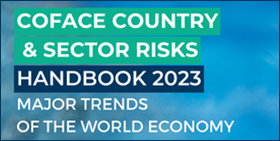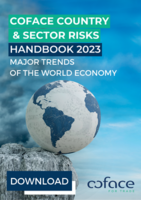Coface country and sector risks handbook 2023: major trends of the world economy

Coface launches the 2023 edition of its Country & Sector Risks Handbook in a brand new format but as always with our much anticipated country and sector risk assessments.
Our economic research team offers you their analysis and forecasts for 160 countries and 13 sectors.
For Xavier Durand, Coface CEO, 2023 will be a pivotal year:
WHAT WILL 2023 BRING?
"Growth is likely to remain sluggish overall (close to zero), as in the United States (below 1%) and in most developed countries.
Global growth will be driven almost exclusively by the emerging economies, especially commodity producing countries, which will benefit from both the reduced activism of Western central banks – led by the Federal Reserve – and the recovery of the Chinese economy.
After an expected epidemic peak at the turn of spring, activity in China should rebound significantly, buoyed by domestic demand that has been particularly sluggish over the past two years, particularly at the household level, where excess savings seem likely to finance a very strong recovery in consumer spending. Given the growing discontent of the population, the government also seems eager to support activity, as suggested, for instance, by the recent relaxation of control measures or prudential constraints on some sectors (ICT, real estate, etc.).
Needless to say, this rather optimistic view is not risk-free. The transformation of the world is accelerating and the multidimensional crisis we are experiencing is not about to end. Most of last year’s themes will remain at the heart of the agenda, first and foremost the energy crisis and the inflationary hydra. The latter are obviously not solely cyclical and linked to the sanctions against Russia and the impact of the pandemic, but are also, and above all, the legacy of chronic underinvestment in the energy system and, most certainly, the price to be paid for its decarbonisation. While undeniably welcome, the decline in inflation in recent months may therefore be only transitory, and the price surge observed since the reopening of the economies could be the prelude to a new, structurally higher inflation regime.
This is even truer as isolationist forces, inherently inflationary, are resurfacing and raising the risk of fragmentation, which is clearly not in the interest of either the collective or any specific country. So how will the monetary and fiscal authorities react, even if we look at the problem only from this angle? Will the fight against inflation, which is at the heart of the mandate of the former, come into open conflict with the objectives of governments? As you can see, the year ahead is fraught with risks on all fronts – macroeconomic, financial, social, political, etc. – and could see the world economy, depending on the choices that are made, fall into recession or finally get on the (right) track for sustainable, inclusive and virtuous development."
The twenty-seventh edition of this handbook addresses all these questions and attempts to answer them by adopting, as customary, a dual geographical and sectoral approach. Download it now!
And for further information we invite you to check for free our comprehensive 160 countries and 13 sectors risk assessment files in our Economic studies section.




